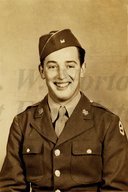
|

|
|
|
|
One of four children of David H. Knotts and Loretta Embrey Knotts, David was born in Neosho, Missouri. The family moved to Joplin, Missouri, where his father drove a truck delivering candies and crackers to grocery stores, earning eighty dollars a month. Meanwhile, David took care of the garden, milked the cow, and fed the chickens and pigs. When he was "about twelve" the family moved to Gladewater, Texas, where David played sports in school and earned a dollar a day at Sunny Land, an ice cream parlor, "flipping burgers or waiting on cars." David graduated from Gladewater High School in 1942 and went to work in the oil field for fifty cents an hour. On May 22, 1943 he married Audrey Cloud. (They would have three children, five grandchildren, and four great-grandchildren). He entered service that year and was sent to the combat engineers at Camp Swift near Bastrop, Texas, where he remained eight months as part of 206th Combat Engineer Battalion, 146th Combat Engineer Regiment. He sailed to England on the SS Santa Maria. There for the next eight months, his unit, the 206th, built redeployment camps, including kitchen facilities, latrines, and living quarters for 1,250 soldiers. Meanwhile, they continued training, going on forced marches of "ten miles out and ten miles back." They also trained in building bridges, as well as handling explosives. He recalls his unit's main task was "to keep everything open for our troops." As the D-Day invasion got underway, David watched the skies fill with airplanes. "I'd never seen so many airplanes in my life, or heard them," he says. Ready to sail, but delayed by a storm, David finally entered Europe a few days later, coming ashore on Omaha Beach, and camping near Sainte-Mere-Eglise. David served as sergeant of a squad, tasked to "keep the roads clear of mines and obstructions." The 206th was attached to 3rd Army under General George S. Patton, Jr., when the breakout of the hedgerow country began on August 1, 1944. "When we were with Patton we knew that we were going to move. We didn't do any building or anything because we were on the move all the time," he comments. At St. Lo, where the 206th was attached to 7th Armored Division, his squad "removed explosives and bulldozed cars and trucks out of the way." They also built a bridge across the Seine River. At the Saar River, Germans shelled bridges they erected so they crossed the 9th Division on rafts made from pontoon sections. All during the march across Europe, they operated on little sleep and subsisted mainly on K and C rations, scavenged food, and an occasional hot meal. That winter of 1944-45, one of his important duties was to see that his squad got dry socks to avoid frostbite. Once his unit crossed the Rhine, he says, "We just didn't slow down." He helped the 65th Infantry Division cross the Danube in wooden rowboats, carrying as many as fifteen men. He and other men of the 206th were detailed to accompany cavalry and help keep the roads clear. "We were supposed to see that they didn't get stopped," he says. He was in a little village near Munich when the war ended. "We got to take a bath," he says. "First thing was they brought showers up to us." Returning to France, he began training, he believed, for the invasion of Japan. Meanwhile, he also attended a semester at American Bridge University "down on the Mediterranean." It was a period, he recalls, that helped ease his transition from war into peacetime. David sailed home on a Victory ship and was discharged with the rank of sergeant at Camp Fannin near Tyler, Texas. He went into sales in oil field equipment, and eventually worked for Hal Baker Engineers. He retired in the 1990s. |


